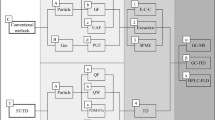Abstract
A newly designed styrene-divinylbenzene copolymer adsorbent packed solid-phase extraction (SPE)-type collection device for the quantitative determination of airborne polycyclic aromatic hydrocarbons (PAHs) containing two to five rings is reported in this manuscript. This SPE-type collection device offers rapid, easy and quantitative elution of the analytes and easier reuse. A small collection device was initially developed for investigating the basic collection and elution performances of the adsorbent with respect to PAHs. The analytes were quantitatively collected on the adsorbent up to 3 m3 of air sampling at a sampling temperature of 35°C. The collected analytes were then completely eluted from the adsorbent by passing 3 mL of dichloromethane without carry-over of the analyte. During air collection, because no moisture was trapped on the adsorbent, the subsequent gas chromatography–mass spectrometric analysis was not influenced by moisture. Based on these successful performances, a wide-bore collection device was introduced for collecting larger air samples. After a quantitative investigation of the collection and elution performances of the widebore collection device, it device was successfully applied for precise determinations of PAHs in atmospheric air. Further application and employment of the device for the precise determination of semi-volatile organic compounds in environmental air samples is expected due to these excellent results.
Similar content being viewed by others
References
S. C. Chen and C. M. Liao, Sci. Total Environ., 2006, 366, 112.
“Some Non-heterocyclic Polycyclic Aromatic Hydrocarbons and Some Related Exposures, IARC Monogr. Eval. Carcinog. Risks Hum.”, International Agency for Research on Cancer, 2010, 92, 1.
“Polycyclic Aromatic Hydrocarbons, in Air Quality Guidelines for Europe”, World Health Organization Regional Office for Europe, Copenhagen, 2010, 92.
S. O. Baek, R. A. Field, M. E. Goldstone, P. W. Kirk, J. N. Lester, and R. Perry, Water Air Soil. Poll., 1991, 60, 279.
C. Venkataraman, S. Thomas, and P. Kulkarni, J. Aerosol. Sci., 1999, 30, 759.
R. E. Cochran, N. Dongari, H. Jeong, J. Beránek, S. Haddadi, J. Shipp, and A. Kubátová, Anal. Chim. Acta, 2012, 740, 93.
D. Yamasaki, H. Kajiwara, M. Kirii, S. Ohira, and K. Toda, Bunseki Kagaku, 2015, 64, 571.
Compendium Methods TO-13A, “Determination of Polycyclic Aromatic Hydrocarbons (PAHs) in Ambient Air Using Gas Chromatography/Mass Spectrometry (GC-MS)”, 1999, US Environmental Protection Agency, Cincinnati, OH.
T. F. Guerin, J. Environ. Monit., 1999, 1, 63.
S. K. Pandey, K.-H. Kim, and R. J. C. Brown, Trends Anal. Chem., 2011, 30, 1716.
Y. Kobayashi, H. Okochi, H. Ogata, and T. Nagoya, Bunseki Kagaku, 2013, 62, 879.
L. Kuusimäki, K. Peltones, P. Mutanen, and K. Savela, Ann. Occup. Hyg., 2003, 47, 389.
J. J. Lee, K.-L. Huang, Y. Y. Yu, and M. S. Chen, Atoms. Environ., 2004, 38, 6185.
Y. Araki, N. Tang, M. Ohno, T. Kameda, A. Toriba, and K. Hayakawa, J. Health Sci., 2009, 55, 77.
NIOSH Manual of Analytical Methods (NMAM) Method 5515, “Polynuclear Aromatic Hydrocarbons by GC”, 4th ed., 1994, U.S. National Institute for Occupational Safety and Health.
A. Kobayashi, Y. Kojima, H. Okochi, and T. Nagoya, Bunseki Kagaku, 2010, 59, 645.
K. Li, H. Li, L. Liu, Y. Hashi, T. Maeda, and J. M. Lin, J. Chromatogr. A, 2007, 1154, 74.
I. Ueta, M. Onikata, S. Mochizuki, K. Fuiimura, T. Sasaki, J. Aoki, and T. Maeda, J. Sep. Sci., 2015, 38, 3891.
I. Ueta, M. Onikata, K. Fujimura, T. Sasaki, T. Yoshimura, S. Mochizuki, and T. Maeda, Chromatography, 2016, 37, 9.
I. Ueta, M. Onikata, K. Fujimura, T. Yoshimura, S. Narukami, S. Mochizuki, T. Sasaki, and T. Maeda, J. Sep. Sci., 2016, 39, 4202.
T. Spitzer, Anal. Chem., 1983, 55, 2226.
Acknowledgments
This work was supported by JSPS KAKENHI (Grant Number 15K17875). One of the authors (I. U.) acknowledges support from Prof. Y. Saito, Toyohashi University of Technology and from S. Kawakubo of University of Yamanashi.
Author information
Authors and Affiliations
Corresponding author
Electronic supplementary material
Rights and permissions
About this article
Cite this article
Ueta, I., Onikata, M., Fujimura, K. et al. A Newly Designed Solid-Phase Extraction-type Collection Device for Precise Determination of Polycyclic Aromatic Hydrocarbons in Air. ANAL. SCI. 33, 1175–1180 (2017). https://doi.org/10.2116/analsci.33.1175
Received:
Accepted:
Published:
Issue Date:
DOI: https://doi.org/10.2116/analsci.33.1175



